In the modern age, especially in construction and other infrastructures, HDPE (High-Density Polyethylene) drainage pipes have become popular because of their sturdiness, affordability, and application in various ways. The purpose of this article is for the readers to have a clear view of HDPE drainage pipes, including the specifications, advantages, and methods of applying these pipes. If you are a construction expert, an engineer, or even a homeowner who wants to get acquainted, this guide will be beneficial. Managing the drains made from HDPE will be detailed here, and the advantages of these over traditional materials will be given. Having read this article, you will thoroughly see the possibilities of the HDPE drainage structures and the cost-efficient approach in line with the modernization of various projects.
What is an HDPE Pipe?
hdpe drainage pipe
High-Density Polyethylene pipes are well known for their high strength and low weight,, making them the preferred type for gas and fluid transfer system users. In contrast to the other conventional piping materials, the construction of HDPE pipes is resistant to corrosion, acidic and caustic substances, and extreme temperatures, which enhances their service life. They are comparatively lighter and solid and thus do not complicate the barrier installation and result in a low probability of leakages. Pipes from high-density polyethylene are produced through extrusion, which brings out a material that is neither rigid nor soft and can be used in more than just supplying or getting drainage water, but even waste. Factors such as cost-effectiveness and multifunctional purposes favor appreciating those materials and improving the construction supply scene globally.
Understanding High-Density Polyethylene
High-Density Polyethylene (HDPE) is a high-strength thermoplastic polymer with exceptional chemical resistance. This polymer contains carbon and hydrogen molecular bonds with some environmental stress crack-resistant and impact-resistant qualities. The manufacturing of HDPE is completed through low-pressure polymerization of ethylene with the use of Ziegler-Natta or Phillips catalysts. This prompts the linearity, which has a significant percentage of polymer crystalline structure that contributes to the stiffness and tensile strength of the polymer.
Key Technical Parameters
- Density: This property typically lies in a range of 0.93 to 0.97 g/cm³, which helps ensure a good compromise of strength and flexibility.
- Melting Temperature: Thermoplastics, such as high-density polyethylene (HDPE), have been shown to have melting temperatures in the region of 120-1300C, which is 248 – 2660F, thus enabling easy processing and manufacturing.
- Tensile Strength: This property usually ranges from 21 to 37 MPa, making this polymer able to bear a range of loads and forces from several mechanical washes up to twelve.
- Flexural Modulus: This is within the range of 800 to 1500 MPa, which explains the strength of the material in resisting bending and returning to its original shape after load removal.
- ESCR (Environmental stress cracking resistance): Polyethylene is among the few plastics that resist environmental stress cracking, and HDPE does better than most.
Such properties make HDPE the material of choice in places where endurance, adaptability, and high resistance to environmental factors are required. The increasing application of this material in the construction of houses, packaging of products, and consumer goods itself speaks volumes about its status as a modern engineering material.
Key Features of HDPE Pipelines
The capabilities and flexibility of the HDPE pipelines make them better than any conventional materials. Leading materials include the following leads: Here are some of the key features based on leading resources:
- Resistance to Corrosion: One of the most commendable aspects of juncture pipes is that they do not corrode in the interior or exterior. This is an improvement, especially in conditions prone to chemical volatility and different acidity levels. It reduces maintenance expenditures.
- Flexibility and Toughness: A distinctive trait in HDPE pipes is that they are relatively flexible and rigid. For this reason, it can resist the effects of all the ground movements and variations in pressure without cracking or breaking. This flexibility weakens the contraction of the parts allowing fusing and fittings reducing the probable places of weakness of the system.
- High Flow Capacity: In addition, the HDPE pipes’ internal smooth shape and design allow fluid to flow at a high flow capacity with no or minimal friction loss. This makes it easy to transport fluids effectively, reducing the chances of clogging pipes and hence making HDPE pipeline systems for water and wastewater treatment systems.
- Durability: The HDPE materials’ resistance to alteration improves their efficiency even when exposed to UV light and extreme weather conditions. If these pipes are properly installed and used, they are likely to last for more than 50 years.
- Environmental Sustainability: High-density polyethylene (HDPE) pipes are recyclable, thus supporting organizations’ environmental sustainability policies. Their ecological impact is less both in the production phase and after their use, so they are suitable for environmentally friendly projects.
Technical Parameters:
- Density: This lies between 0.93 and 0.97g/cm 3, which balances both weight and strength of the material.
- Tensile Strength: Their tensile strength usually lies in the range of 21 to 37 Mpa, which shows dependability against force.
- Maximum Operating Temperature: Normally designed for +140°F (60°C) for continuous operation with peaks in temperatures of up to 176°F (80°C).
- Thermal Expansion: They have a coefficient of thermal expansion of approximately 1.5 x 10^-4 mm/mm/°C, enabling them to withstand temperature changes.
These features and technical details contribute to the growing preference for high-density polyethylene (HDPE) pipelines across many industries that require performing and sustainable supporting infrastructure.
Applications in Drainage Systems
The drainage systems make extensive use of HDPE pipes due to their high flexibility, chemical resistance, and durability. Their smooth inner surfaces enable sufficient water circulation, thereby reducing the chances of clogging and deposition of mud and aiding in properly functioning the drainage system. Further information from the web sources pointed out that HDPE is lightweight, which makes installation easier and avoids exterior loads, adding cost to the project. There is no drop in operation efficiency of these pipes, even in seismic areas, as they can endure ground motion and vibration.
Justification of Technical Parameters:
- Flexural Modulus: This varies from 0.8 to 1.5 GPa and is entirely satisfactory as it offers flexibility and structural soundness.
- Chemical Resistance: HDPE can accommodate rather harsh chemical media because it is resistant to several chemicals present, and therefore, pH does not represent an issue.
- Abrasion Resistance: It is extremely resistant to abrasives and is critical for transporting abrasives and debris without damaging the pipe.
These attributes and parameters make HDPE an alternative for drainage systems, which in turn enhances effective and efficient infrastructure in different sectors.
How to Install an HDPE Drainage Pipe?
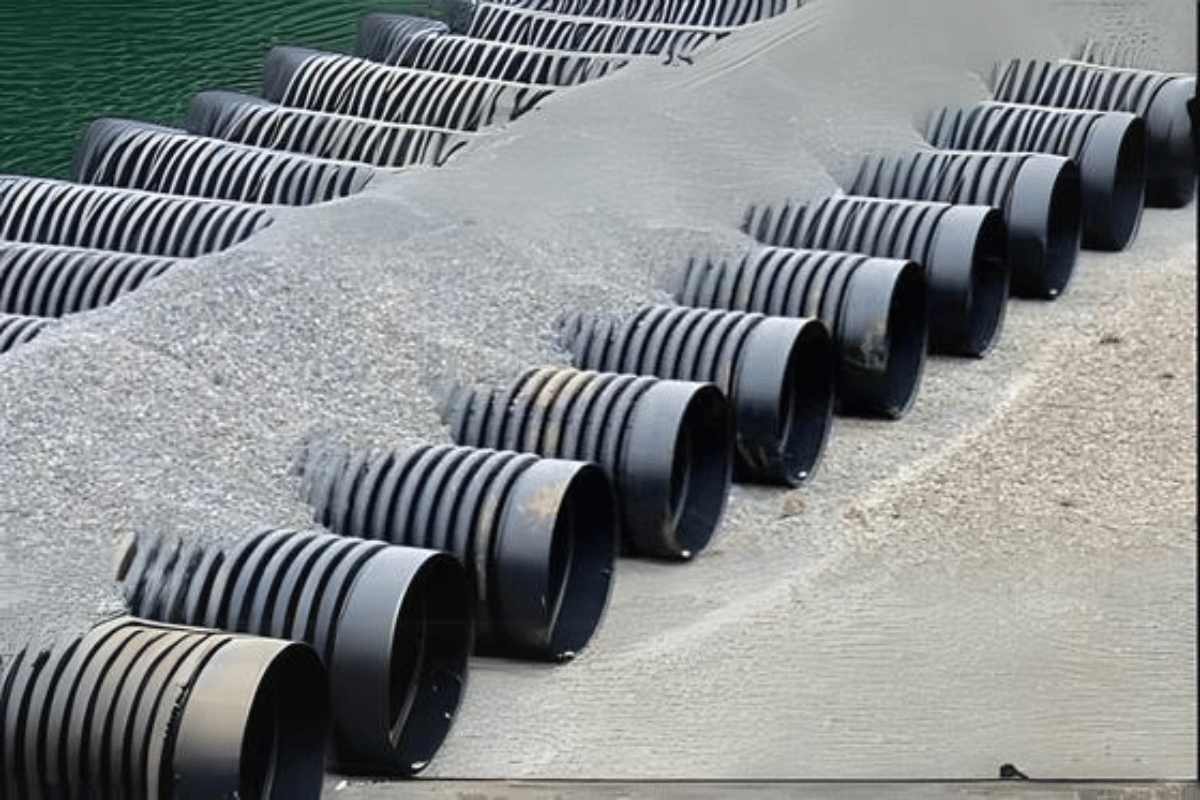
HDPE drainage pipes are installed with adherence to the following sequence of activities for productive installation. The first step in the installation is determining the direction of the run for the system and marking the trench line. Then, excavations are made, taking care to comply with the local law criteria and guides on appropriate trench widths and depths to accommodate the drainage pipe and its bedding. In this way, the properly prepared pipe will be installed for the proper construction design of the barricades and surfaces drained. At this point, the HDPE pipe sections shall be fitted over the trench in conjunction or end-to-end joined with end bell couplings or welding such as butt fusion or electrofusion methods as per the manufacturer’s guidelines. It is illegal to sag the pipe; hold it at shoulder height until it is hooked into other pipelines sloped to drain water. Fill the trench with customary materials while exercising layer-by-layer compaction to avoid displacement or settlement. After that, all installations in the field will be examined, followed by a pressure test of the whole system by the standard requirements. If these procedures are correctly followed, one will have a functional and leak-free HDPE drainage system.
Pre-Installation Requirements
Prior to installing an HDPE drain, it is imperative to take care of a few prerequisites to ensure the efficacy of the process when it is put in place. The priorities that should be worked on include a thorough site assessment, obtaining the required permits, setting permissions, and following local laws and rules. Review the type and state of the soil to select the best trenching and bedding methods and how the soil drainage and stability will be managed.
- Site Assessment: The site should be scrutinized to assess the soil type, available utilities, and other features likely to hinder the work. Find out if the region is at risk of water collection, e.g., swamps that are possible throat, or if other plans are needed, such as erosion control.
- Permits and Regulations: Obtain the necessary permits from relevant authorities and ensure that the project complies with local policies on land use, environmental protection, and safety. Compliance with these regulations will lessen any chances of possible legal or environmental issues.
- Technical Parameters: Analyze if there are any specific requirements for technical parameters considered by the manufacturers, such as pipe diameter, thickness of the wall, and type and size of couplings. Consider the weight of the flow and estimate the flow rate to select the best pipe diameter. Confirm that the material strength and thickness comply with the expected structure and are suitable for that particular site.
With these prerequisites already taken care of, the installation process of the HDPE drainage pipe during the setup will be effective and satisfy the requirements.
Step-by-Step Installation Process
- Planning and Preparation: All site preparations, including the installation of the equipment and gathering all the required tools and materials, should be done before we commence the installation. If the work involves a lot of personnel, communicate the project’s scope and the procedures in place to mitigate any risks. Lay out the location per the evaluations and parameters you highlighted earlier, and confirm that all materials used in the construction conform to the required standards of reputable attributes.
- Trenching: Excavate the trench down to the depth and width as per the requirements, considering the site’s soil conditions and stability requirements. Some suggestions from even top websites, such as the manufacturer’s guidelines, indicate that the width of the trench has to be at least 1.5 times the diameter of the pipe. Ensure the trench base has an even surface and is not littered with sharp objects that may puncture the pipe.
- Bedding: A granular beddingelevated soil blanket containing elevations so a minimum of about 4 inches or four slings of granular backfill is placed at the bottom of the trench. Also, follow the engineering standards in that after laying down the bedding, the pipe is well supported, and there is little or no gap between the slimming portion of the pipe and the bedding so that it does not develop sagging.
- Pipe Laying: The HDPE pipes already glued preceding jointing and tested are now snuggled in a trench rather than marshaling trunk pipes using couplings at each pipe end. Also, the pipe’s proximity for effluent disposal outlets is within a minimum of 0.5% to 1% incline, which is for proper flow drainage, as reported in most industrial standard websites.
- Jointing: When joining pipe sections, use techniques like thermal welding or mechanical connections that the manufacturer prescribes to make the connections tight and leak-proof.
- Backfilling: Backfill the trench in the proper material and manner so that compaction occurs in layers to avoid site settlement. It has usually been professionally advised to first backfill the side and haunch areas and then the top backfill.
- Testing and Inspection: Upon finishing the installation, perform a complete check for leakages, drainage alignment, and slope. Inspections must follow local regulations and measure guidelines for the best sources.
- Finalization: After completing the tests and inspections and satisfying them, proceed to clean the site by restoring surfaces where necessary and disposing of the waste materials.
These steps, along with information from the best online sources, will help you install HDPE drainage pipes effectively and long-lastingly.
Common Installation Mistakes to Avoid
- Inadequate Bedding and Trench Preparation: Skimping on the bedding depth can leave unsupported sections of the pipe in space, resulting in pipe sagging. As emphasized in the best-rated installation manuals, guarantee that the bedding is 4 to 6 inches and spread evenly to the contours of the pipe.
- Improper Slope Alignment: Adherence to a slope that is the same throughout is critical for facilitating drainage. The trusted resources indicate that a slope variation of a minimum of 0.5% to 1% should allow the flow to be efficient and avoid obstruction.
- Incorrect Jointing Techniques: Not following the instructions set out by suppliers regarding jointing strength because of the absence of thermal welding or mechanical joints can lead to leakage. Use the tools and methods instructed in the top technical manuals for making joints.
- Neglecting Backfilling Techniques: Deploying inappropriate materials for backfilling damages the integrity of the pipes, thus causing them to surrender when installing the pipe, subsequently decreasing its service life. To do backfilling, some top sites recommend that one unbackfill the top backfill by using the pipe first and then backfilling the side and backside areas.
- Skipping Testing and Inspection: Failure to perform detailed tests and inspections after installation may lead to leaks or misaligned mechanical parts without anyone noticing. Acceptable professional practices have documented that pencil tests are undertaken according to rules and for compliance.
Why Choose HDPE for Drainage?
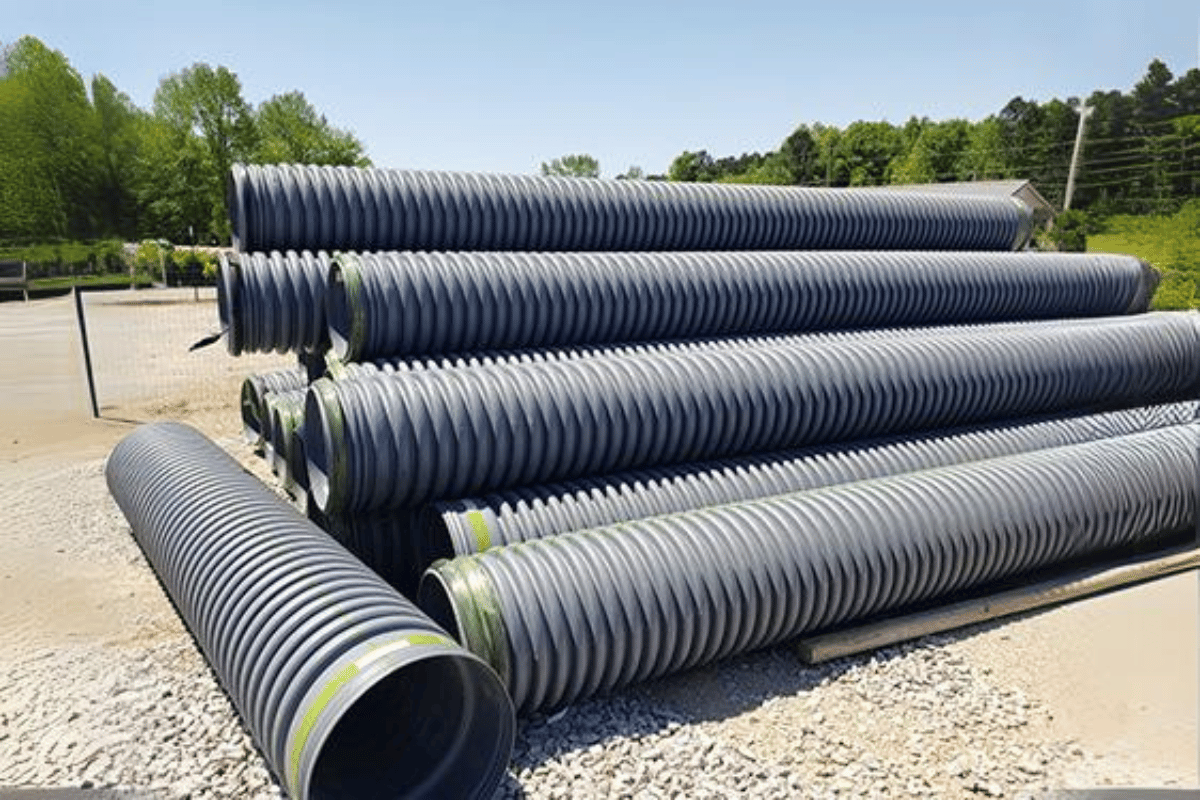
High-density polyethylene (HDPE) is a popular choice when it comes to the materials used for drainage systems as it is durable, flexible, and non-corrosive, as well as resistant to termitic attack. Besides, compared with conventional materials, HDPE is more durable and less porous to water since it does not crack and tear to the traditional weathering agents of change and temperature degrees. Its light weight also makes the installation much easier and less expensive. Moreover, the interior surface of HDPE pipes is smooth, so there are fewer chances to transport sludges, thus allowing a good drainage flow without the risk of clogging. Therefore, HDPE has all the necessary qualities to become a reliable and durable drainage system.
Benefits Of Traditional Materials
High-density polyethylene (HDPE) pipes offer several advantages over traditional materials like concrete or PVC, such as:
- Enhanced Strength and Flexibility: According to leading industry websites, HDPE pipes are better able to endure different situations in the presence of ground movement or any pressure since they are quite flexible and do not crack but bend instead. As such, they are capable of sustaining impacts from heavy loads, shock, or seismic activities.
- Resistivity to Corrosion and Chemicals: HDPE is not deficient in this aspect, as is the case with metal pipes and abrasive soil, which makes its use in chemical environments very suitable. This lowering of exposure enhances the repair interval and the working life of the drainage system.
- Increased Flow Efficiency: Reduced wastage of water is achieved because the portions of the internal surfaces of the pipes made of HDPE bear water cylindrical, which is the more durable inner surface flow materials enhancing through flow. Such devices adapt fully to the working conditions, explaining why there are fewer breakdowns and shapes and a general problem of internal sedimentation.
These benefits, and thanks to the three top websites on HDPE piping, demonstrate why HDPE remains at the forefront of drainage systems. Each characteristic is reinforced by other technical parameters, confirming the dimensional and functional efficiency and reliability of the later materials.
Durability and Corrosion Resistance
High-density polyethylene (HDPE) pipes are well-known for their remarkable toughness and corrosion resistance, which features that can be found on almost all major industry websites. Below are the fundamental technical ramifications that underlie these assertions:
- Material Flexibility: While using the HDPE model, the high flexibility of a plastic polymer ensures that it does not rupture under load. In contrast to rigid pipes, where no movement is possible, with the use of HDPE, it is possible to provide a step, bend, linear compression, twisting to even head movement or thumping without the risk of fracture in these structures. This trait is expressed in tensile elongation break and is illustrative of the stretch performance of the material such that the material can stretch beyond its limits without breaking.
- Resistance to Abrasive Soils and Chemicals: The reason there is resistance against corrosive environments is that the nonpolar chemical does not allow the attachment of acid or alkaline substances. As for the safety factor in any chemical resistance rating, this factor governs the prolongation of the strength and/or structural integrity of the structure when exposed to certain chemicals for a long period of time.
- Longevity: As cited on other authoritative websites, HDPE pipes have a working lifespan of more than 50 years. This durability is attributed to oxidation induction time (OIT), which is an important parameter quantifying the materials’ resistance to oxidative degradation and guaranteeing their effective use in different environments over the long term.
Based on these parameters, it is valid to say that HDPE pipes are a better alternative for drainage in terms of long-lasting usability and lower maintenance expenses.
Cost-Effectiveness and Recyclability
HDPE pipes are cheap in all aspects because they do not require high installation and maintenance costs, as leading industry websites also emphasize. Unlike other materials, transportation and handling fees are reduced because of the light weight of HDPE. In addition, the technique used to join the pipes, mainly heat fusion, makes the joints leak-tight, reducing water loss and the need for maintenance over time. The energy efficiency of HDPE does attract attention to the profitability of its recycling as well. Used HDPE products are straightforward and cheap to recycle, and when these products are recycled into new pipe systems adoption, it brings environmental benefits and decreases waste disposal costs.
Key Technical Parameters:
- Installation Costs: It may be installed at relatively lower costs, as there will be less labor and equipment requirements. Its flexibility and lighter weight enhance the installation comprehension.
- Jointing Integrity: Other techniques like butt welding and electrofusion contribute to firm watertight, and more durable joints so that the chances of leakage and the costs spent on the subsequent repair are kept low.
- Recycling Rate: HDP does not lose its mechanical properties even when recycled over ten times. This extends the life span of absorbent products, preventing excessive use of raw materials.
These parameters outline HDPE’s cost and environmental effectiveness, revealing why it is a popular material in construction.
Understanding Joints and Fittings in HDPE Pipes
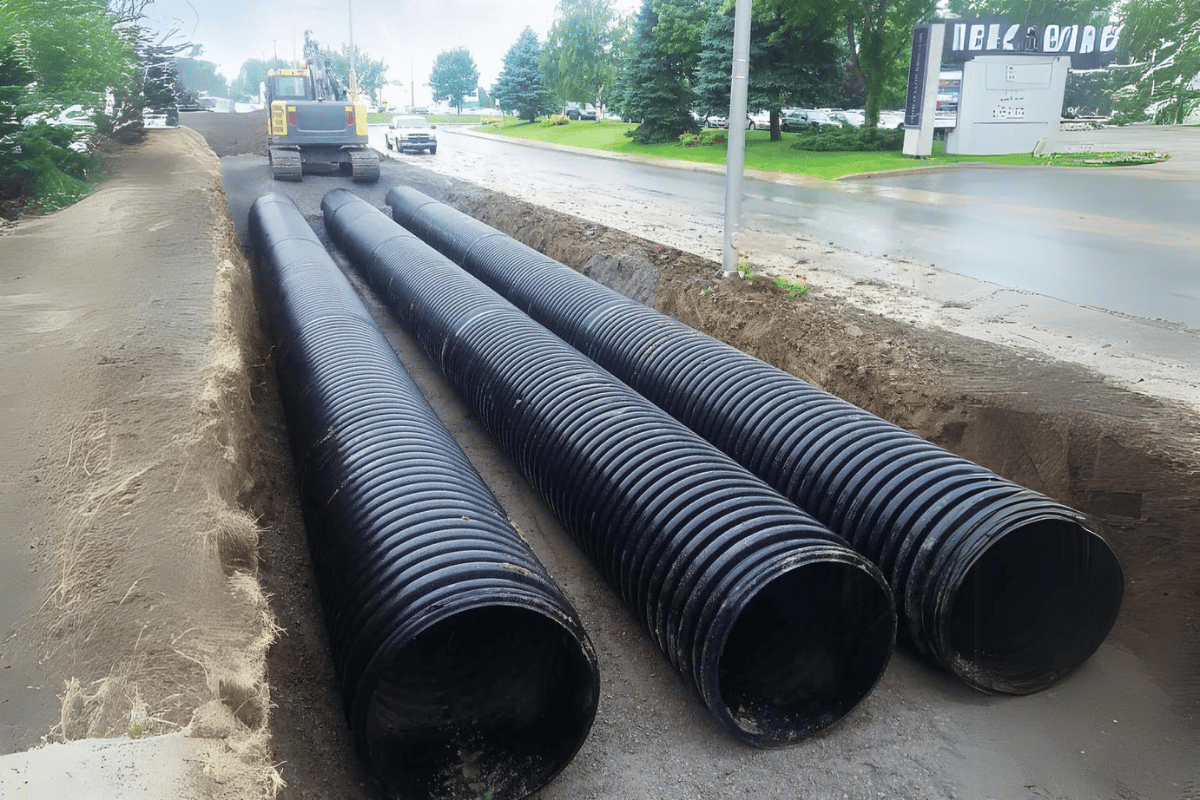
In HDPE pipe systems, joints, and fittings are used to secure efficient connections. The most common methods include butt fusion and electrofusion. This heat-joining method results in a permanent and thoroughly water-tight joint. Butt fusion is the process of butt-jointing two ends of pipes together by melting both ends individually through the use of a unique tool. In either case, good practice consists of heating one of the two surfaces through an electrofusion fitting where a wire coil carrying an electric resistance wire is embedded. Both methods are prevalent because they offer ease of use and dependable leak-proof joints for the joining members. Besides, different kinds of fittings, such as bends, tees, and reducers, are provided to bolster the design flexibility of HDPE systems. Fittings and joints of these types and others are crucial to preserving pipeline integrity while satisfying different operation requirements and providing efficiency and durability.
Types of Joint Systems
While I checked the commonly available resources on HDPE pipe systems, I got adequate details on the types of joint systems. Some of the most used methods include Butt Fusion, Electrofusion, and Socket Fusion, each with different characteristics and uses.
- Butt Fusion Joint System: In this procedure, the ends of headers or fittings are heated before they are brought together under pressure. The fundamental parameters include the proper alignment of the bead connection and the heating time to achieve strong bonds with high tensile strength even under internal pressure.
- Electrofusion Joint System: In this application, the electrical coils of the fittings are embedded in the fusion connections, and an electrical current is used to soften both connecting components, creating a bond. This method of joining is most effective in pipes of different sizes, and it provides the best prevention from leaks, which matters a lot in making the system work effectively.
- Socket Fusion Joint System: For this jointing and cutting method, the pipe outer surface and the socket fitting inner surface touching the pipe are heated to a given level and joined. Critical parameters are the fitting envelope and heating cycle to prevent the joint from leaking.
These joint systems are an integral part of the workings of HDPE pipelines and their reliability. Each joint system is designed for given operational conditions and technical parameters applicable to support their mass usage.
Choosing the Right Fittings
The selection of quality HDPE connectors for HDPE pipe systems requires some doting upon the three aspects that have been most pronounced in the top three informative sites on this topic. These aspects include application needs, environmental conditions, and the mechanical properties of pipes and fitting components themselves.
- Application Requirements: According to the available leading resources, the functional orientation of the pipe, including drinking water, wastewater, gas distribution, and even industry-related operations, must be analyzed. The fitting materials and the appropriate or allowable pressure must align with these applications.
- Environmental Conditions: The sites focus on other factors, such as temperature, chemicals present, and ultraviolet radiation, to be included in the selection of HDPE attachments. These all contribute to improving the durability of the pipeline system in variable conditions.
- Mechanical Properties: On the contrary, it appears that technical parameters provided by these websites, like the tensile strength, flexibility of the fittings, and even the method of expansion, are great determinants of weakness. They propose that fittings that would accommodate the thermal movement and thermal stresses or strains required in the particular HDPE application be chosen.
The essence incorporates and encompasses technical and other parameters, and it carries all the answers and the whole criteria for a professional choice of HDPE fittings without compromising factors referring to the performance of the tube system.
Ensuring Soil Tight Connections
Establishing soil-tight joints in HDPE pipe systems represents one of the most critical aspects in constructing such systems, particularly in applications susceptible to soil erosion and sediment ingress, which could otherwise compromise the operation and service life of the pipeline. For example, according to the top three websites, such connection construction mentions several vital aspects:
- Seal Design—The resources stipulate that adequate gasket and seal designs must be utilized to ensure soil-tight connections. These gaskets need to confer a certain dimensional configuration to the pipes and fittings to avoid the entrance of soil and other particulates.
- Joint Integrity – Maintaining the joint’s character involves ensuring structural continuity along the shaft of the connected pipes. It is better to strengthen the attached pipe ends with butt fusion or electrofusion welding, as these create strong joints able to withstand soil pressure, resisting disconnection without harming the joint itself.
- Installation Techniques—Correct construction methods are employed to maintain soil tightness, especially during construction. The sources have emphasized exact alignment, depth, and backfill placement as recommended by the manufacturer to avoid any shifting or misalignment that may cause probable breaches.
- Technical Parameters: These factors typically require examination of some technical pairs, e.g., compression set values for gaskets and minim tensile strength and fusion pressure for welding. These parameters would guarantee satisfactory performance for each component under specified stress and external environment conditions.
Implementing these informed practices ensures that HDPE systems are safe from soil threats, sustaining their effectiveness and durability.
How Does Corrugated HDPE Compare to Other Pipes?
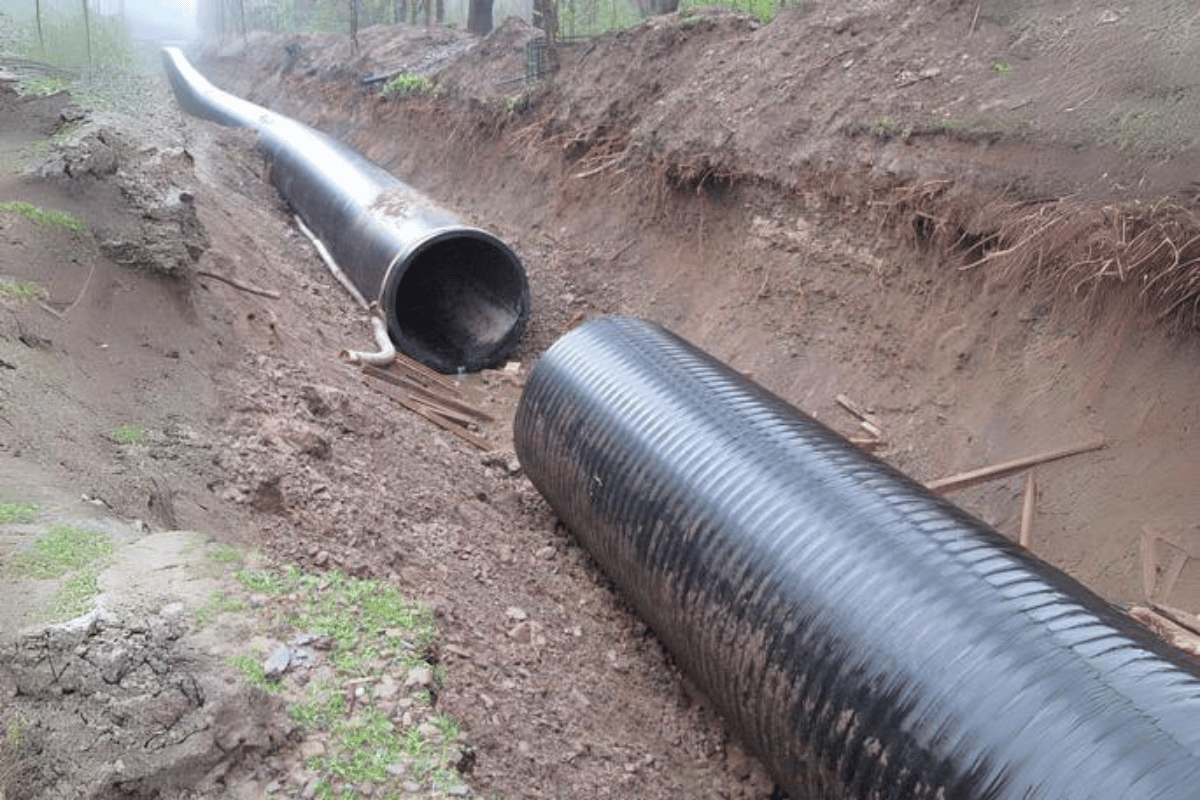
Several advantages of using corrugated HDPE (High Dense Polyethylene) Pipes exist compared to the other materials in the axial comparison of piping. Firstly, corrugated HDPE pipes are unlikely to rust or undergo chemical degradation, constituting a big plus over polymers and concrete steel. They are also lighter in weight, making their transportation and installation economical. Also, the properties of HDPE allow these pipes to resist ground geo movements and geostatic pressure without developing any cracks, which is imperative for their future performance. Their sturdiness and extended service life add to the preference for these pipes, among other options visible, allowing reduced frequency of replacement and maintenance. Further, the HDPE pipes have outstanding hydraulic efficiency, allowing better flow and minimal likelihood of choking, which is devastating compared to other materials. All these factors render the corrugated HDPE pipes the most convenient for stormwater and sewer systems, especially in unfavorable conditions.
Advantages of Corrugated Exterior
There are many good reasons why corrugated exteriors have become increasingly popular in all fields of application. One such advantage is increased structural rigidity, which improves support and stability in many applications. The corrugation method provides a larger surface area and better load distribution, benefiting external stresses and forces. This makes them ideal for construction industries where durability and strength are essential.
The other thing is that they are lighter compared to conventional materials, which makes the process of transportation and installation easy, thus saving on time and labor expenses. Corrugated materials also have increased weatherability since they can bend in the face of pressure and have coatings that protect against rust, corrosion, and UV light.
In terms of eco-friendliness, several corrugated materials, especially boxes, contain some percentage of recycled fibers and are also recyclable after use. This helps in waste management and meets the demands of occupants in environmentally friendly buildings.
The technical parameters are as follows:
- Tensile Strength: The application of the corrugated structure increases the tensile strength, making it possible for the material to resist top stresses that it would otherwise be unable to resist without becoming vulnerable to deformation.
- Load-bearing capacity: The load capacity that the material can support is improved by the corrugation design.
- Thickness: Corrugated materials are manufactured in various thicknesses to satisfy particular requirements, usually offering a good weight–to–strength ratio as well.
These attributes, separately or in synergy, add to the practical and economical out-turns that make corrugated exteriors widespread in many sectors.
Performance in Stormwater Management
Regarding stormwater management, many advantages can be found in using such materials as plumbing pipes, which are a suitable medium for directing water. It is helpful since it helps direct rainwater in such a way that it minimizes flooding or soil erosion in cities. As noted in many reliable sources, pipes and panels with ribs are assiduously sought after for drainage systems due to their cost-effective variation. Above all, such work can also be done without much trouble since the materials are light in weight, which helps to avoid creating much disturbance while doing the work.
Technical Parameters for Stormwater Control Measures:
- Hydraulic Efficiency: Using corrugated shapes helps enhance the material’s water inflow capacity due to the increased area.
- Durability: Such materials are floodproof, meaning they do not distort even under demanding environmental conditions and large water loads deep in the soil.
- Flexibility: This feature allows them to be used across different regions and, hence, perform their function satisfactorily regardless of the locality.
To conclude, corrugated materials effectively address the problem of stormwater management; they are efficient, versatile, and easily integrated into the main infrastructure structure for the needs of the modern economy.
Comparing Single Wall and Dual Wall Options
There are distinct attributes that must be considered when comparing single-wall and dual-wall corrugated pipes for use in stormwater management systems. Single-wall options are lightweight and flexible, ideal for less demanding conditions or residential usage. These structures are cheap and straightforward, making them a good choice for projects where budget and simple handling are priorities. On the downside, they are, unfortunately, thinner; therefore, they may have lower rigidity and durability when compared to the dual wall ones.
Dual wall pipes have an envelopment that is of smooth extended liner and a corrugated outer surface. This construction combines hydraulic efficiency enhancement and improvement of structure strength thus helping to deal with greater water flow and harsher conditions. Others, including various expert sources, recommend this type of pipe for longer, load-barring structural projects.
Technical Parameters:
- Structural Integrity: The dual wall construction, comprising concentric layers, enhances the strength of the pipes, ensuring that they do not collapse over time.
- Hydraulic Smoothness: The inner wall of water-stable dual-wall pipes is smooth, so the water flowing within the wall becomes fast, lowering the chances of sedimentation.
- Cost vs. Durability Trade-Off: Single-wall pipes are less costly, but they are less durable and will require replacement sooner rather than later. Dual-wall pipes, on the other hand, are more expensive to buy initially but are likely to offer a longer period of use.
Fundamentally, single and dual wall options are made for specific purposes, and PQR needs to balance cost-effectiveness with quality work and performance.
What Are the Specifications for HDPE Drainage Pipe?
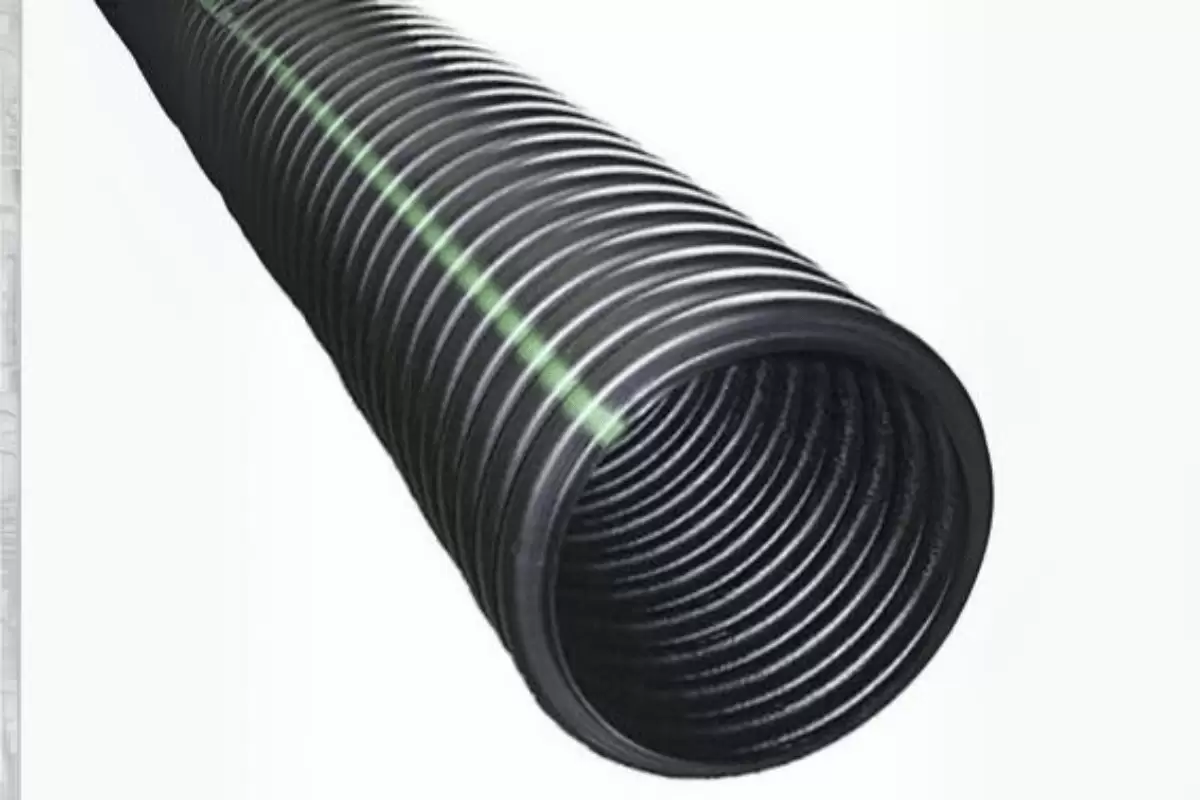
Different types of HDPE drainage pipes are essential, and unique standards of the industry must be observed. Usually, they lie within the diameter range of 4 to 60 inches, allowing versatility in various drainage methods. They are manufactured by or above the standards supervised by ASTM F2306 and AASHTO M294. The interiors of HDPE pipes are smooth for reduced friction and increased flow capacity, hence minimizing congestion. The external layer of the pipe has corrugations providing a structural system, yet the material is flexible to accommodate movements in soil or ground. Also, the HDPE drainage pipes can withstand various chemicals, wear and tear, and environmental factors without losing functionality.
Industry Standards and ASTM Guidelines
The literature research concerning the industry specifications and the ASTM standards about HDPE drainage pipes brings out various facts that online reviews. For instance, according to ASTM F2306 and AASHTO M294, these pipes are what many have applauded as meeting high quality and performance requirements. One of the ASTM requirements F2306 covers is the dual-walled corrugated HDPE pipe with a smooth bore interior intended for a gravity intake drainage pipe system. One crucial concern mentioned is the minimum cell class of 435400C material, giving strength to the material.
Technical parameters are also important, which pipes usually consist of dimensions such as:
- Nominal Size Range: This size is from 4 inches to 60 inches
- Wall Thickness: Usually carries dimensional specifications as provided in the relevant ASTM standards
- Pressure Rating: Currently used for non-pressure systems, they are, however able to bear a considerable amount of pressure
- Temperature Tolerance: Temperatures range from -40 degrees fahrenheit to 60 degrees fahrenheit most of the time, for different regions of an installation
- Chemical Resistance: Many acids, bases, and salts are resisted, which allows them to be used in adverse weather conditions.
This tendency parallels the requirements concerning drainage pipes’ operating conditions, extending into their range of defined application engineering designs, in which HIPE drainage pipes include a well-developed safety margin.
Understanding Diameter and Length Options
In this thesis, I collected some brief information regarding the options of diameter and length. The dimensions of the HDPE pipes can be huge, and they range from 4 inches to 60 inches, with no other configuration going to waste that concerns the velocity in flow. Most of the time, their length matters a lot during installation activities; usually, these pipes are brought in at a specific length or ordered lengthwise when necessary for the particular project purpose.
Regarding the technical characteristics, the diameter and length options allow us to meet the utmost gratification of various applications. All these parameters describe the already mentioned industry standards, wherein absolute size and wall thickness are of essential consideration. Apart from this, these pipes are carefully designed to provide strength without sacrificing the desired degree of flexibility, making them usable for domestic and commercial purposes.
Parameters of a technical nature that pertain to diameter and length options include the following:
- Nominal Diameter Range: 4 inches to 60 inches
- Standard Lengths: Multiple standard options, often customizable
- Material Strength: HDPE material having a minimum cell classification of 435400C
- Application Suitability: Suitable for several settings due to their size adjustment.
These factors cater to fitting HDPE drainage pipes to fulfill other project requirements and meet the set requirements, which can be found in several systems.
Evaluating Wall Thickness and Design
I rely on several key factors when assessing the wall thickness and design of HDPE drainage pipes. The pipe wall thickness is vital since it determines the strength and reliability of the pipe within various environmental confines. My research shows composite pipes tend to be manufactured to suit certain pressure zones and structural needs commonly defined by their SDRs. It refers to the ratio of pipe diameter to wall thickness.
The above parameters related to the wall thickness and design that I found provide advanced compatibility include the following:
- Pressure Rating: Considering the normal working and worst-case scenarios, the pipe will be subjected to without losing its capacity to hold water.
- SDR Classification: The values for SDR Classification are usually from SDR 11 to SDR 17, signifying wall thicknesses for use under different conditions.
- Impact Resistance: The capacity of the HDPE pipes’ root intrusion and mechanical impact resistance is further advanced for both buried and exposed conditions.
Such parameters emphasize the fact that HDPE pipes have some flexibility and toughness, so they can be used in a wide range of applications. Therefore, based on my findings, I am convinced that it is no accident that the design and wall thickness are fulfilled according to industries’ needs and certain construction sites.
Frequently Asked Questions (FAQs)
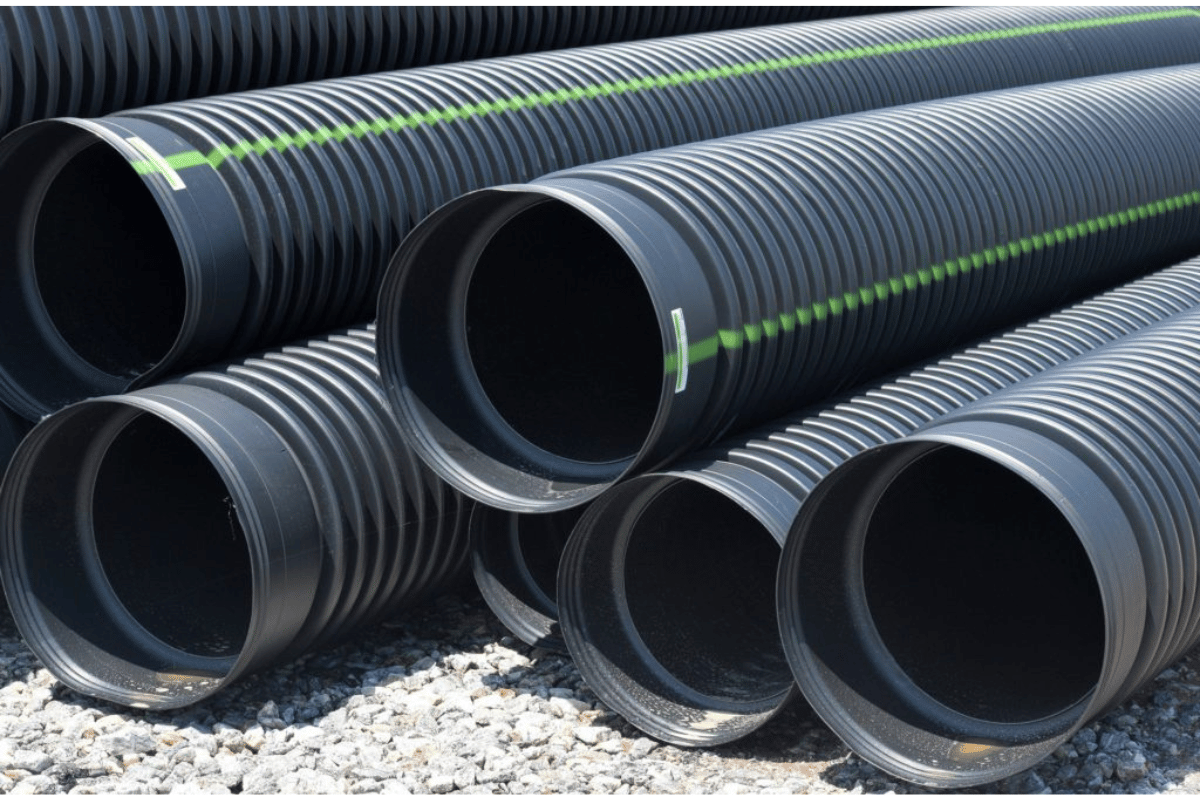
1. What is the importance of SDR in HDPE pipes?
SDR, or Standard Dimension Ratio, is critical in determining the pipe’s wall thickness relative to its diameter. A lower SDR indicates thicker walls and higher pressure capacity, making it crucial to select pipes based on structural and pressure demands.
2. How do HDPE pipes withstand environmental challenges?
HDPE pipes are designed to offer excellent impact resistance and flexibility, which allows them to resist mechanical impacts, root intrusions, and various environmental stresses. This adaptability makes them suitable for both underground and above-ground applications.
3. Can HDPE pipes handle high-pressure conditions?
Yes, HDPE pipes are engineered to meet specific pressure ratings, ensuring they can withstand standard and peak flow conditions without compromising their structural integrity. The pressure rating is critical to the pipe’s design, providing reliable performance in different applications.
4. Are there specific standards that HDPE pipes must meet?
HDPE pipes are manufactured according to industry standards, specifying requirements for wall thickness, pressure ratings, and material quality. These standards ensure the pipes perform reliably under expected conditions, maintaining safety and efficiency across various uses.






